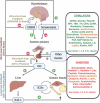A Comparative Update on the Neuroendocrine Regulation of Growth Hormone in Vertebrates
- PMID: 33708174
- PMCID: PMC7940767
- DOI: 10.3389/fendo.2020.614981
A Comparative Update on the Neuroendocrine Regulation of Growth Hormone in Vertebrates
Abstract
Growth hormone (GH), mainly produced from the pituitary somatotrophs is a key endocrine regulator of somatic growth. GH, a pleiotropic hormone, is also involved in regulating vital processes, including nutrition, reproduction, physical activity, neuroprotection, immunity, and osmotic pressure in vertebrates. The dysregulation of the pituitary GH and hepatic insulin-like growth factors (IGFs) affects many cellular processes associated with growth promotion, including protein synthesis, cell proliferation and metabolism, leading to growth disorders. The metabolic and growth effects of GH have interesting applications in different fields, including the livestock industry and aquaculture. The latest discoveries on new regulators of pituitary GH synthesis and secretion deserve our attention. These novel regulators include the stimulators adropin, klotho, and the fibroblast growth factors, as well as the inhibitors, nucleobindin-encoded peptides (nesfatin-1 and nesfatin-1-like peptide) and irisin. This review aims for a comparative analysis of our current understanding of the endocrine regulation of GH from the pituitary of vertebrates. In addition, we will consider useful pharmacological molecules (i.e. stimulators and inhibitors of the GH signaling pathways) that are important in studying GH and somatotroph biology. The main goal of this review is to provide an overview and update on GH regulators in 2020. While an extensive review of each of the GH regulators and an in-depth analysis of specifics are beyond its scope, we have compiled information on the main endogenous and pharmacological regulators to facilitate an easy access. Overall, this review aims to serve as a resource on GH endocrinology for a beginner to intermediate level knowledge seeker on this topic.
Keywords: cell signaling; growth hormone; hormones; neuropeptides; pituitary; somatotrophs cells; vertebrates.
Copyright © 2021 Vélez and Unniappan.
Conflict of interest statement
The authors declare that the research was conducted in the absence of any commercial or financial relationships that could be construed as a potential conflict of interest.
Figures


Similar articles
-
Regulation of growth hormone release in common carp pituitary cells by pituitary adenylate cyclase-activating polypeptide: signal transduction involves cAMP- and calcium-dependent mechanisms.Neuroendocrinology. 2002 Nov;76(5):325-38. doi: 10.1159/000066627. Neuroendocrinology. 2002. PMID: 12457043
-
Tilapia adropin: the localization and regulation of growth hormone gene expression in pituitary cells.Peptides. 2017 Nov;97:1-7. doi: 10.1016/j.peptides.2017.09.009. Epub 2017 Sep 14. Peptides. 2017. PMID: 28917652
-
Hypophysiotropic action of pituitary adenylate cyclase-activating polypeptide (PACAP) in the goldfish: immunohistochemical demonstration of PACAP in the pituitary, PACAP stimulation of growth hormone release from pituitary cells, and molecular cloning of pituitary type I PACAP receptor.Endocrinology. 1998 Aug;139(8):3465-79. doi: 10.1210/endo.139.8.6145. Endocrinology. 1998. PMID: 9681497
-
Understanding the multifactorial control of growth hormone release by somatotropes: lessons from comparative endocrinology.Ann N Y Acad Sci. 2009 Apr;1163:137-53. doi: 10.1111/j.1749-6632.2008.03660.x. Ann N Y Acad Sci. 2009. PMID: 19456335 Review.
-
Peripheral regulation of the growth hormone-insulin-like growth factor system in fish and other vertebrates.Comp Biochem Physiol A Mol Integr Physiol. 2012 Nov;163(3-4):231-45. doi: 10.1016/j.cbpa.2012.08.003. Epub 2012 Aug 14. Comp Biochem Physiol A Mol Integr Physiol. 2012. PMID: 22909791 Review.
Cited by
-
Somatotroph Tumors and the Epigenetic Status of the GNAS Locus.Int J Mol Sci. 2021 Jul 15;22(14):7570. doi: 10.3390/ijms22147570. Int J Mol Sci. 2021. PMID: 34299200 Free PMC article.
-
Protective Effects of PACAP in a Rat Model of Diabetic Neuropathy.Int J Mol Sci. 2021 Oct 2;22(19):10691. doi: 10.3390/ijms221910691. Int J Mol Sci. 2021. PMID: 34639032 Free PMC article.
-
Recombinant Bovine Growth Hormone-Induced Metabolic Remodelling Enhances Growth of Gilthead Sea-Bream (Sparus aurata): Insights from Stable Isotopes Composition and Proteomics.Int J Mol Sci. 2021 Dec 3;22(23):13107. doi: 10.3390/ijms222313107. Int J Mol Sci. 2021. PMID: 34884912 Free PMC article.
-
GHRH in diabetes and metabolism.Rev Endocr Metab Disord. 2025 Jun;26(3):413-426. doi: 10.1007/s11154-024-09930-9. Epub 2024 Nov 19. Rev Endocr Metab Disord. 2025. PMID: 39560873 Free PMC article. Review.
-
Tissue explants as tools for studying the epigenetic modulation of the GH-IGF-I axis in farmed fish.Front Physiol. 2024 Jun 20;15:1410660. doi: 10.3389/fphys.2024.1410660. eCollection 2024. Front Physiol. 2024. PMID: 38966230 Free PMC article.
References
-
- Strobl JS, Thomas MJ. Human growth hormone. Pharmacol Rev (1994) 46:1–34. - PubMed
-
- Ergun–Longmire B, Wajnrajch MP. Growth and growth disorders. In: Endotext. Available at: https://www.ncbi.nlm.nih.gov/books/NBK279142/ (Accessed October 6, 2020).
-
- Carroll PV, Jenkins PJ. Acromegaly. In: Endotext. MDText.com, Inc. Available at: http://www.ncbi.nlm.nih.gov/pubmed/25905322 (Accessed October 6, 2020).
Publication types
MeSH terms
Substances
Grants and funding
LinkOut - more resources
Full Text Sources
Other Literature Sources

